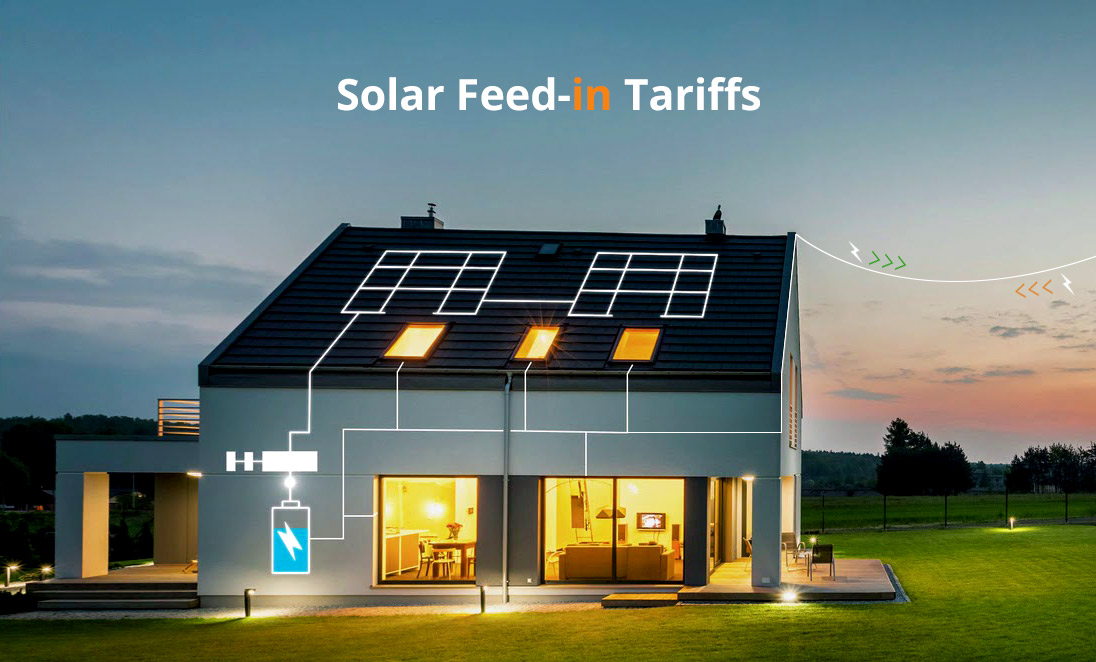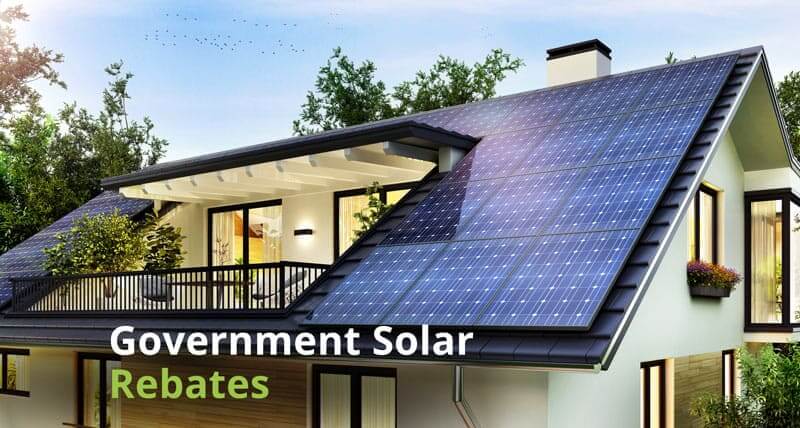In Oz, when you’ve got a bit of extra sunshine juice from your solar panels, you can flog it off back to the power grid and make a tidy sum. Yeah, that’s right, it’s all about pocketing a few extra bucks for the energy you’re not using anyway. The blokes who have to cough up the cash? The energy companies. But how much you’ll pocket depends on who’s providing your power and where your home is parked. Why keep reading? Because knowing the ins and outs could mean more coin in your pocket for a rainy day.
Below, we have listed the feed-in tariff rates for solar energy by supplier.

| Electricity Retailer | Max FiT | Contact Number |
|---|---|---|
| 8.1c | Go to site |
|
| 7.6c | Go to site |
|
| 7.0c | Go to site |
|
 | 7.0c | Go to site |
| 7.0c | Go to site |
|
 | 7.0c | Go to site |
| 6.0c | Go to site |
|
| 6.0c | Go to site |
|
 | 6.7c | Go to site |
| 6.2c | Go to site |
|
| 5.0c | Go to site |
|
| 5.0c | Go to site |
|
| 5.99c | Go to site |
|
 | 5.5c | Go to site |
 | 5.2c | Go to site |
| 4.4c | Go to site |
|
| 3.0c | Go to site |
| Electricity Retailer | Min FiT | Contact Details |
|---|---|---|
| 12.0c | Go to site |
|
| 11.0c | Go to site |
|
| 7.0c | Go to site |
|
| 7.0c | Go to site |
|
| 7.0c | Go to site |
|
| 5.5c | Go to site |
|
| 5.4c | Go to site |
|
| 5.4c | Go to site |
|
| 5.2c | Go to site |
|
| 5.2c | Go to site |
|
| 5.0c | Go to site |
|
| 5.0c | Go to site |
|
| 4.9c | Go to site |
|
| 4.9c | Go to site |
|
| 4.9c | Go to site |
|
| 4.9c | Go to site |
|
| 4.9c | Go to site |
|
 | 4.9c | Go to site |
 | 4.9c | Go to site |
| 4.9c | Go to site |
|
| 4.9c | Go to site |
|
| 3.9c | Go to site |
| Electricity Retailer | Max FiT | Contact Details |
|---|---|---|
| 10.7c | Go to site |
|
| 8.0c | Go to site |
|
 | 8.0c | Go to site |
| 7.0c | Go to site |
|
| 6.6c | Go to site |
|
| 6.0c | Go to site |
|
| 6.0c | Go to site |
|
| 5.5c | Go to site |
|
| 5.5c | Go to site |
|
 | 5.2c | Go to site |
 | 5.0c | Go to site |
| 5.0c | Go to site |
|
 | 5.0c | Go to site |
 | 5.0c | Go to site |
| 5.0c | Go to site |
|
| 4.5c | Go to site |
|
| 4.0c | Go to site |
|
| 3.85c | Go to site |
|
| 3.0c | Go to site |
|
| 2.73c | Go to site |
| Electricity Retailer | Max FiT | Contact Details |
|---|---|---|
| 8.5c | Go to site |
|
| 8.0c | Go to site |
|
| 8.0c | Go to site |
|
| 7.0c | Go to site |
|
| 6.0c | Go to site |
|
 | 6.0c | Go to site |
 | 6.0c | Go to site |
| 5.5c | Go to site |
|
| 5.5c | Go to site |
|
| 5.5c | Go to site |
|
 | 5.2c | Go to site |
| 5.0c | Go to site |
|
| 5.0c | Go to site |
|
| 5.0c | Go to site |
|
| 5.0c | Go to site |
|
| 3.5c | Go to site |
|
| 3.0c | Go to site |
|
| 2.48c | Go to site |
|
| 2.0c | Go to site |
|
| 1.0c | Go to site |
| Electricity Retailer | Min FiT | Contact Details |
|---|---|---|
| 7.6c | Go to site |
|
| 7.1c | Go to site |
|
| 5.91c | Go to site |
|
| 4.4c | Go to site |
|
| 5.5c | Go to site |
| Company | Max FiT | Contact Details |
|---|---|---|
| 10.87c | Go to site |
|
| 10.87c | Go to site |
|
 | 10.87c | Go to site |
| 10.87c | Go to site |
| Electricity Retailer | Min FiT | Max FiT | Contact Details |
|---|---|---|---|
 | 12c | 12c | Go to site |
 | 8c | 8c | Go to site |
| 7.1c | 7.1c | Go to site |
| Electricity Retailer | Min FiT | Max FiT | Contact Details |
|---|---|---|---|
 | Not Available | Not Available | Go to site |
 | 7.1c | 7.1c | Go to site |
What is a Feed-In Tariff?
Feed-in Tariffs are financial incentives for utility companies to solar system owners when they produce energy in excess of their consumption. The additional energy is fed back into the grid and energy providers pay you a rate for the exported energy.
Feed-in tariffs are applicable for various forms of renewable energy such as wind, solar, hydro, and biomass. But for the sake of this guide, we will only focus on feed-in tariffs related to solar energy.
Feed-in tariffs encourage the adoption of solar energy in a bid to reduce greenhouse gases and pollution. It creates a “win-win” situation for homeowners who can reduce their energy bills by installing solar power and also get paid back for the excess energy produced.
The feed-in tariff is applicable only for residential installations and doesn’t apply to commercial energy producers. The feed-in tariff is also referred to as a solar bonus scheme or a solar buyback rate.
How do Feed-In Tariffs Works?
Consider your solar power system as a tiny power station. The extra energy your rooftop solar panels generate that is not used by your home does not go to waste. The additional energy is fed back to the main electricity grid so that others can utilize it.
The feed-in tariff works by you receiving money from your utility company for exporting the excess energy back to the grid.
The feed-in tariff rates received a boost in 2017 when major utility companies decided to increase the rates for homeowners. The scheme makes solar power a sound investment when you consider the high retail price of electricity.
Different energy providers offer different feed-in rates and they also vary from state to state (we will discuss the current rates in a while!).
How is Feed-In Tariff Calculated?
Your energy company will pay you for the excess power based on a fixed rate per kilowatt hour or kWh of energy. To put things in perspective, let’s take an example.
A 5kW solar energy system can generate 350 to 850 kilowatt hours (kWh) in a month. Let’s say your solar panels produce 600 kWh of energy per month.
Now an average household consumes about 13.7 kWh per day. In a month your home will use 13.7 x 30 = 411 kWh.
So you will feed 600 – 411 kWh or 189 kWh to the grid.
Now, if you are in Queensland and your energy provider offers 44c per kWh, you will earn 189 kWh x 44c/kWh = $83.16.
The actual kWh power produced by a 5kW solar panel system depends on the size of your solar power system, the number of sun hours, and the angle of sun exposure, among other factors.
Who Pays the Feed-In Tariff?
Your energy supplier will pay for the extra energy you send back to the grid. The money comes from the energy market and not from the government, as some people believe.
The energy exported to the grid is used up by other people connected to the grid. So the cost of the power is distributed across the customers who consume the power. Your utility company is not paying the feed-in tariff from their pockets but is charging other customers who use the power based on the applicable retail rate.
So they are just handing over the money to you.
What is the Difference between Gross and Net Feed-In Tariff?
Most states in Australia have adopted the net feed-in tariff over gross tariff in recent years.
In the case of gross metering, the total power generated by your solar panels is transferred to the grid for use by others. When your house consumes power, it directly draws from the grid. So you get paid for the power you transfer to the grid and need to pay for the power you draw from the grid.
Now almost all feed-in tariffs are net tariffs. The electricity generated by the solar panels is first used by your home and appliances. Any additional unused power is sent to the grid where you receive a sum for supplying the power.
Your utility company will measure the amount of energy used by your home and also the power sent back to the grid. Then they will pay you accordingly based on whether you used more power or less generated by your panels.
All new connections in Australia now provide only net feed-in tariffs.
Is Feed-In Tariff Same as Solar Rebate?
The answer is no! Solar rebate is an upfront discount on installing a solar rooftop system. These are available to households and small businesses in Australia under the Small-scale Renewable Energy Scheme (SRES).
As we already discussed, the feed-in tariff is the money paid by energy companies for the power you send back to the grid for use by others.
Resource: Visit our homepage for more resources on solar rebate amounts per system size and state.
How do You Qualify for Feed-In Tariff?
While most residents with a solar power system would qualify for a feed-in tariff, you need to meet a few criteria to be eligible.
The first requirement is you should be connected to the grid. Off-the-grid systems with solar panels won’t be able to send back power to the grid and don’t qualify for financial incentives.
Your solar installation should also meet relevant Australian safety standards. If you have employed an accredited solar installer, then you don’t need to worry about this.
Another important criterion is the size of your solar power system. As electricity infrastructure was designed to allow unidirectional flow, many providers put an upper limit on the size of your solar energy system.
Most providers allow a 5 kilowatts (5kW) system for single-phase connections. If you have a three-phase connection, you can go up to 30kW (30kVA) sizes.
Some utility companies allow bigger sizes of 10kW for single-phase connections, while some restrict it to 15kW for three-phase connections. You should consult your energy provider before installing your system to qualify for the feed-in scheme.
How do You Apply for Feed-In Tariff?
You need to submit an application to your utility company after you have installed your solar energy system. Most energy providers have an application form that you can fill out and submit.
The company will determine whether you meet all the requirements and then enter into a contract for a fixed term. The contract is valid as long as you stay in the same house and with the same supplier.
Note: You won’t be able to modify your solar energy system after the contract has been signed. If you have a backup solar battery system and want to add to it, this could affect the contract.
Do You Need to Pay Taxes for Feed-in Tariff Income?
There is a general confusion about whether feed-in tariff income is taxable. But the good news is rulings from The Australian Tax Office (ATO) are increasingly favorable towards solar energy.
Whether you need to pay tax for your feed-in tariff income or not depends on how your building is used. If you are a homeowner who uses the property only for a living, you don’t need to pay any taxes. You will be qualifying for personal use and your earnings won’t form an assessable income.
That makes even 10kW investments worth it!
The earning from feed-in is considered an assessable income only when your property is used for for-profit purposes. So commercial buildings, business owners, investors, and renters will need to pay tax on their income.
What are the Feed-in Tax Considerations for Commercial Properties?
Businesses will need to show their feed-in income as assessable income which brings some tax implications.
- The cost of electricity for your business is an allowable deduction. You will have to offset this deduction with the earnings from feed-in income.
- You will be able to claim deductions for the interest of loans applicable to the solar installation generating the feed-in earnings.
- The depreciation from the income-generating solar energy system can be claimed.
Do I Need to Pay GST on Feed-in Tariff Income?
Generally, homeowners don’t need to pay any GST on the income earned from the feed-in tariff. Your income will only be considered for GST when the total earnings from feed-in energy exceed $75,000 in a year.
That is way above any household will ever earn from feeding back energy to the grid.
So homeowners will not need to register for or remit GST. Commercial properties and businesses, however, will need to pay GST on their feed-in income.
Will Feed-In Tariff Count as Pension Income?
Whether the income from feed-in tariff counts as pension income or not depends on how you receive it. If your utility company provides credits on your electricity bills, then your earning is not considered as income for pension purposes.
So if you receive a discount on your bill, you don’t need to worry.
Feed-in income will only be considered under pension when you receive a cheque or money from your energy company. This can happen only if you feed in more energy than your consumption.
The trick is to carry the surplus to your next bill so that it is not assessed as income.
Even if you go for a cheque, you can enjoy earnings up to $150 (single pensioners) and $264 (partnered pensioners) per fortnight before any reduction is made from your pension. There is little chance of your exceeding this with a residential solar system.
Will Battery Storage Affect My Feed-In Tariff Rates?
Many people wonder whether installing battery storage will impact their feed-in rates.
The rules vary from state to state, so here is a quick overview.
VIC: You can install battery storage with your solar energy system without worries- it won’t impact your feed-in tariffs.
WA: You can continue to enjoy feed-in tariffs if you install non-exporting batteries with your solar installation.
QLD: There is no update if batteries interfere with feed-in tariffs. You should check with your utility company for more details.
NSW: The feed-in rate is only applicable if you generate power through your solar panels. Stored energy fed back to the grid will not qualify for feed-in income.
ACT: You cannot get a feed-in tariff if you have a storage system connected to the source of electricity. Only complaint renewable energy generators are an exception.
SA: In SA, you will not be eligible for feed-in tariffs if you install energy storage batteries.
TAS: Feed-in tariffs are not influenced by storage batteries.
NT: You can install any energy storage system and continue to earn feed-in tariffs.
Feed-In Tariff Rate Comparison
Just to give you an idea of how things work, we are going to make a comparison of feed-in rates from leading energy companies in Australia. We will take a look at the rates of Origin Energy, Energy Australia, and AGL.
As you know, the original rates vary according to your location.
Origin Energy has several plans with Solar Boost Plus and Solar Boost being the most popular ones. You can get the highest feed-in tariff under the Solar Boost Plus plan at 25 c/kWh in states like Victoria and New South Wales. The Solar Boost Plan offers the highest rate of 20 c/kWh in Victoria and New South Wales. The other plans can give you anything from 8 c/kWh to 10 c/kWh as a feed-in tariff.
Energy Australia has the highest feed-in tariff in Queensland at 16.1 c/kWh. Victoria has the lowest rate at 9.9 c/kWh without considering the time-based tariff. In peak hours, you can earn 29 c/kWh while during off-peak hours you can get 7.1 c/kWh.
AGL increased its feed-in tariffs in 2017 and the highest rate is available in South Australia at 16.3 c/kWh. AGL offers the lowest rate in Queensland at 10.6 c/kWh.
Now we will present the feed-in tariff rates for each state along with the contact details of each energy company.
Solar Power Feed-In Tariff by State
Now we will take a look at the feed-in tariffs offered by various energy companies in Australia. We have classified the rates according to the states with high, low, and average rates.
Who has the Best Solar Feed-In Tariff in NSW?
As you can see, Origin Energy has the best solar feed-in tariff in NSW. The company pays the lowest of 8.0 c/kWh while the highest rate is 25.0 c/kWh. You can expect an average of 16.50 c/kWh for your excess energy fed into the grid.
You will get a flat feed-in tariff at all times of the day.
Who has the Best Solar Feed-In Tariff in VIC?
Origin Energy again tops the chart with an average feed-in tariff of 17.0 cents/kWh. The highest tariff is 25.0 cents/kWh while the lowest you can get is 9.9 cents/kWh.
The Victoria’s Essential Services Commission has implemented a time-based feed-in tariff system which will become compulsory after a year. The rates are as follows.
3pm to 9pm – 29 c/kWh
7am to 3pm – 10.3 c/kWh
10pm to 7am – 7.1 c/kWh
Who has the Best Solar Feed-In Tariff in QLD?
On average, Energy Australia provides the best feed-in tariff in QLD. The highest rate and the lowest rate are the same at 16.1 c/kWh.
Who has the Best Solar Feed-In Tariff in SA?
AGL provides the best feed-in rate in SA at an average of 18.15 c/kWh. The highest rate is 20.0 c/kWh while the lowest is 16.3 c/kWh.
Who has the Best Solar Feed-In Tariff in ACT?
You can get the best feed-in tariff in ACT from Origin Energy at an average of 14.0 c/kWh. The highest rate is 20.0 c/kWh and the lowest is 8.0 c/kWh.
Who has the Best Solar Feed-In Tariff in WA?
You can get the best feed-in tariff in ACT from Origin Energy at an average of 14.0 c/kWh. The highest rate is 20.0 c/kWh and the lowest is 8.0 c/kWh.
Who has the Best Solar Feed-In Tariff in NT?
Jacana Energy with a steady offering of 23.6 c/kWh provides the best feed-in tariff in NT.
Existing customers of Power Water Corporation in the Alice Solar City project can get a gross feed-in rate of 51.28 c/kWh with a cap of $5 per day.
Who has the Best Solar Feed-In Tariff in TAS?
1st Energy offers the best solar feed-in tariff with an average rate of 11.0 c/kWh. The highest you can get is 13.5 c/kWh while the lowest rate is 8.5 c/kWh.
Table of Contents
Toggle




